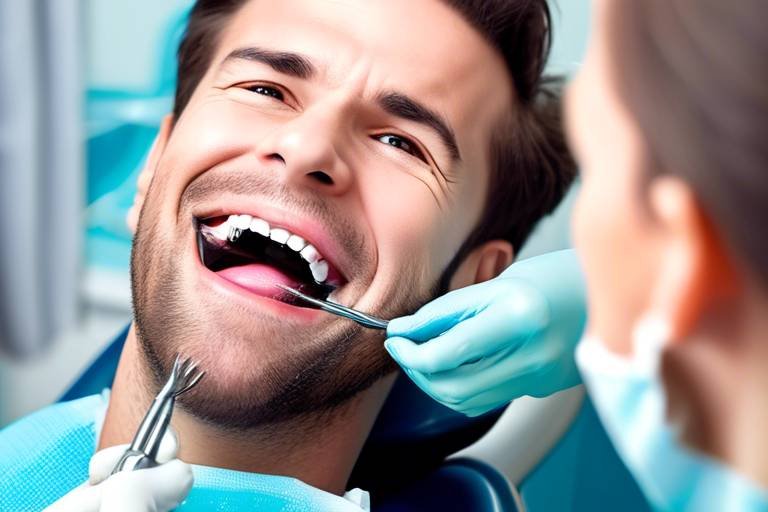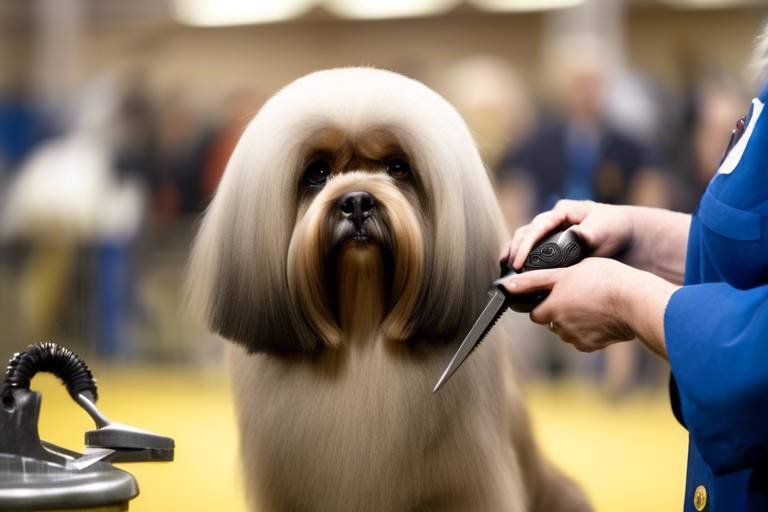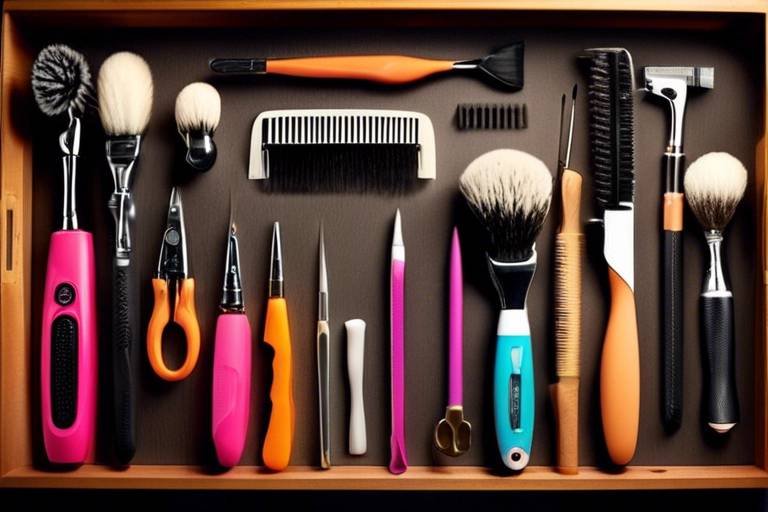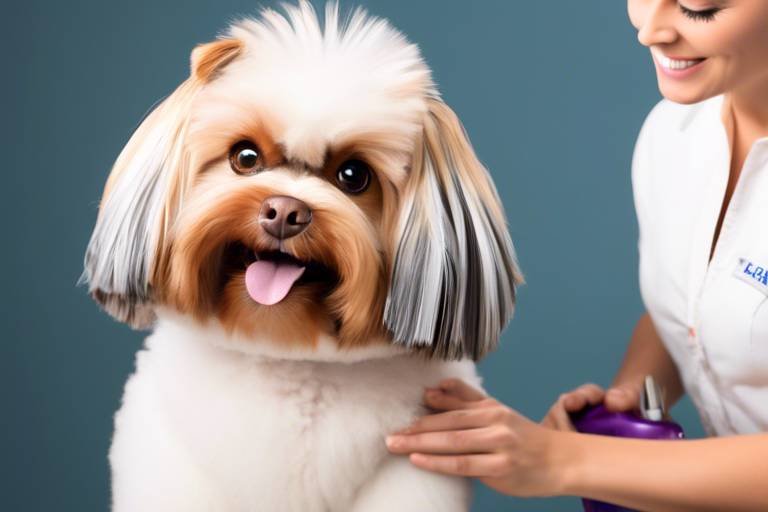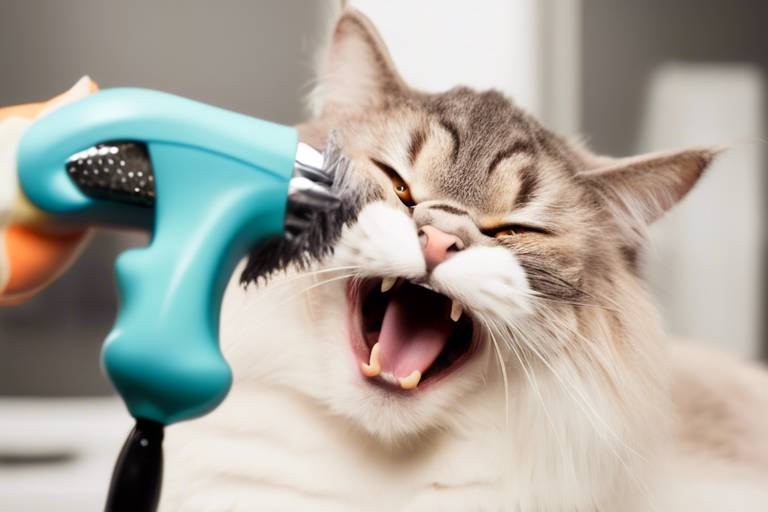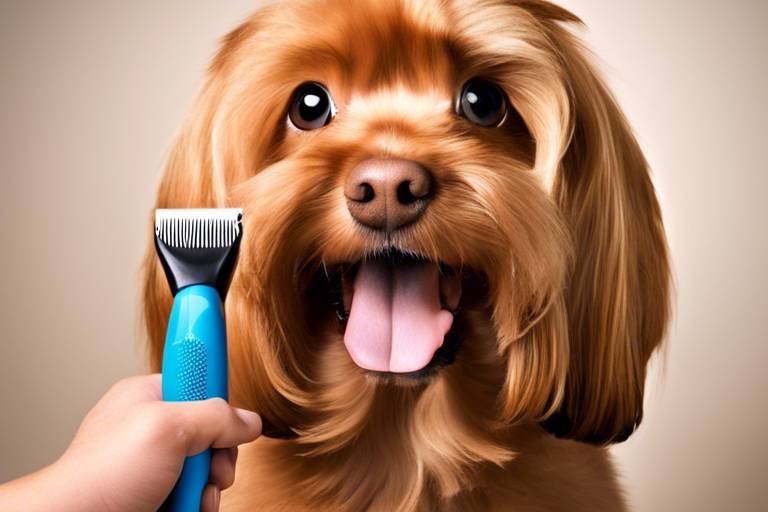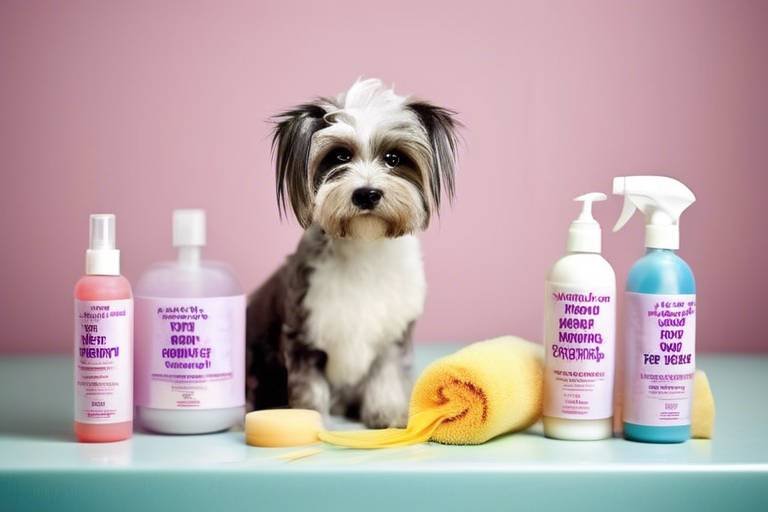How to Spot Dental Problems During Grooming
As a loving pet owner, you probably look forward to grooming sessions with your furry friend. But did you know that these moments can also serve as a golden opportunity to spot dental problems? Just as we check our own teeth regularly, it's crucial to keep an eye on our pets' dental health. During grooming, you can easily notice signs that may indicate underlying dental issues. So, let's dive into the world of pet dental care and discover how to identify potential problems while keeping your pet looking fabulous!
Before we jump into the signs to look for, it’s essential to understand the most common dental problems that can affect your pet. Conditions like periodontal disease and tooth decay are not just nuisances; they can lead to severe health complications if left untreated. Periodontal disease, for instance, starts with plaque buildup and can progress to serious infections that affect the gums and even the bones that support the teeth. Similarly, tooth decay can cause pain and lead to tooth loss, impacting your pet's ability to eat and enjoy their food.
Now that we have a grasp on common dental problems, let’s explore the signs that can alert you to potential issues. Early detection is key! Here are some red flags to watch for during grooming:
- Bad breath: A little pet breath can be cute, but if your pet's breath smells foul, it might be time to investigate further.
- Difficulty eating: If your pet seems hesitant to eat or struggles with their food, dental pain might be the culprit.
- Swollen gums: Healthy gums should be pink and firm. If you notice any redness or swelling, it could indicate a problem.
Behavioral changes in your pet can be a significant indicator of dental discomfort. Have you noticed your usually playful pup becoming withdrawn or irritable? This shift in behavior could be a cry for help. Pets may express their discomfort through aggression, excessive whining, or simply by avoiding interactions they once enjoyed. It’s as if they’re trying to tell you, “Hey, something’s not right in my mouth!”
Your pet's eating habits can provide invaluable clues about their dental health. If you notice a sudden decrease in appetite or if they seem reluctant to chew on their favorite toys, these could be signs of dental issues. Imagine trying to enjoy a delicious meal while dealing with a toothache—it's not easy! Pay close attention to how your pet approaches their food; any changes could warrant a trip to the vet.
Healthy gums are the foundation of good dental health. During grooming, take a moment to examine your pet's gums. They should be a nice shade of pink and have a smooth texture. If you see redness, swelling, or any discharge, it's a sign that something may be amiss. Think of your pet's gums as the gatekeepers of their oral health; if they’re not healthy, the whole system can be compromised.
Just like we schedule regular check-ups with our dentist, your pet needs routine veterinary dental check-ups too! These professional evaluations are essential for maintaining oral health and preventing serious dental issues down the line. A vet can perform thorough cleanings and identify problems that might not be visible to the untrained eye. Remember, prevention is always better than cure!
Now that you know how to spot dental problems, let’s discuss how you can maintain your pet’s dental hygiene at home. There are various tools and products available that can help make this task easier. From special toothbrushes and toothpaste designed for pets to dental chews that promote healthy teeth, there’s no shortage of options!
Proper brushing techniques are vital for effective dental care. Start by introducing your pet to the toothbrush gradually. Use a soft-bristled brush and a toothpaste formulated for pets. When brushing, make sure to focus on the gum line, as this is where plaque tends to build up. Aim for a gentle, circular motion—think of it as giving your pet a little massage while keeping their teeth clean!
Incorporating special dental treats and toys into your pet's routine can also aid in oral hygiene. These items are designed to reduce plaque and tartar buildup while providing a fun activity for your pet. It's like a two-for-one deal: they get to chew and play while you ensure their teeth stay healthy!
Q: How often should I brush my pet's teeth?
A: Ideally, you should brush your pet's teeth daily. However, even a few times a week can make a significant difference.
Q: What are the signs that my pet needs to see a vet for dental issues?
A: If you notice persistent bad breath, difficulty eating, swollen gums, or any changes in behavior, it’s best to consult your veterinarian.
Q: Are dental chews effective?
A: Yes! Dental chews can help reduce plaque and tartar buildup, but they should complement regular brushing and veterinary check-ups.

Understanding Common Dental Problems
This article provides insights into identifying dental issues in pets during grooming sessions, highlighting the importance of regular dental care and how to recognize signs of trouble effectively.
When it comes to our furry companions, oral health is often overlooked, yet it plays a crucial role in their overall well-being. Just like humans, pets can suffer from a variety of dental issues that can lead to serious health complications if left untreated. Among the most common dental problems are periodontal disease and tooth decay. Periodontal disease is an infection of the tissues surrounding the teeth and is caused by the accumulation of plaque and tartar. This condition can progress silently, leading to tooth loss and even affecting vital organs such as the heart and kidneys.
Tooth decay, on the other hand, occurs when the enamel on a tooth is damaged, leading to cavities. This can be painful for pets and may result in behavioral changes, such as reluctance to eat or play. It’s important to recognize that these dental issues don’t just affect the mouth; they can have a ripple effect on your pet's overall health. For example, bacteria from periodontal disease can enter the bloodstream and cause infections in other parts of the body.
Let’s break down some of the most common dental problems:
- Periodontal Disease: Affects the gums and supporting structures of the teeth.
- Tooth Decay: Results from the breakdown of tooth enamel, leading to cavities.
- Gingivitis: Inflammation of the gums, often a precursor to periodontal disease.
- Broken Teeth: Can occur due to trauma or chewing on hard objects.
Understanding these issues can help you take proactive steps in maintaining your pet's dental health. Regular veterinary check-ups are essential for catching these problems early. Don’t wait for your pet to show signs of distress; be proactive! Just as you wouldn’t ignore a toothache in yourself, it’s crucial to address any dental discomfort your pet may be experiencing.
Recognizing early signs of dental problems is crucial. This section outlines key indicators such as bad breath, difficulty eating, and swollen gums that pet owners should monitor closely.
Changes in behavior can signal dental discomfort. This subheading explores how pets may act differently when experiencing oral pain, such as increased aggression or withdrawal from play.
A pet's eating habits can provide valuable clues. This section discusses how decreased appetite or reluctance to chew can indicate underlying dental issues that need attention.
Healthy gums are vital for dental health. This part emphasizes the importance of examining gum color and texture, as signs of redness or swelling can indicate potential problems.
Routine veterinary dental check-ups are essential for maintaining oral health. This subheading highlights the importance of professional evaluations and cleanings to prevent serious dental issues.
This section discusses various tools and products pet owners can use at home to maintain their pet’s dental hygiene, including toothbrushes, toothpaste, and dental chews.
Proper brushing techniques are crucial for effective dental care. This subheading provides tips on how to brush your pet's teeth correctly to ensure thorough cleaning and comfort.
Special dental treats and toys can aid in oral hygiene. This part explores the benefits of incorporating these items into your pet's routine to promote healthier teeth and gums.
Q: How often should I brush my pet's teeth?
A: Ideally, you should brush your pet's teeth daily. However, even a few times a week can make a significant difference in their dental health.
Q: What are the signs of dental disease in pets?
A: Common signs include bad breath, difficulty eating, swollen gums, and behavioral changes like aggression or withdrawal.
Q: Are dental treats effective?
A: Yes, dental treats can help reduce plaque and tartar buildup, but they should not replace regular brushing and veterinary check-ups.
Q: When should I take my pet to the vet for dental issues?
A: If you notice any signs of dental problems, such as persistent bad breath, difficulty eating, or swollen gums, it’s essential to schedule a vet appointment as soon as possible.
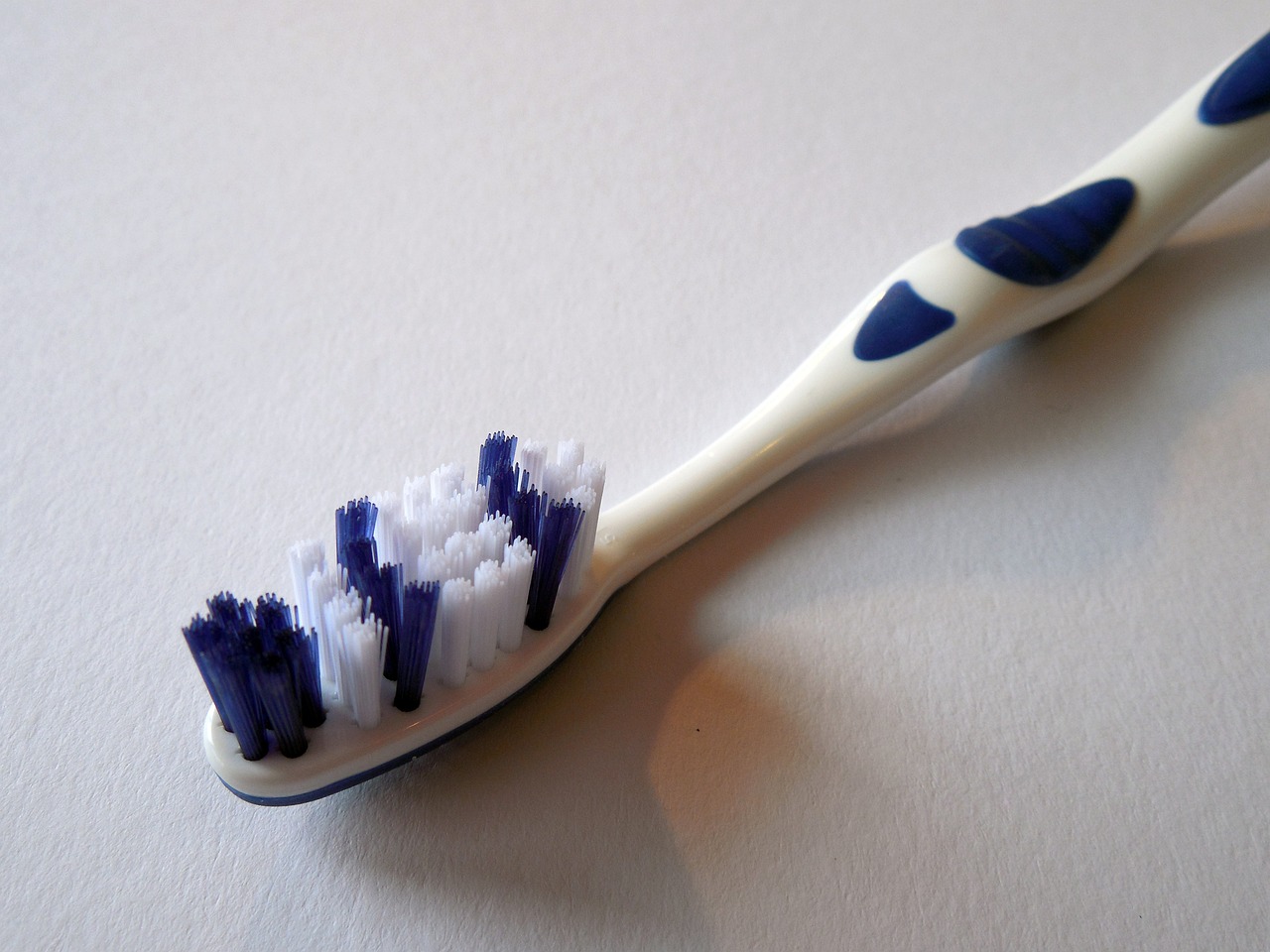
Signs of Dental Issues to Look For
When it comes to our furry friends, their health is our top priority, and that includes their dental hygiene. Just like humans, pets can suffer from a variety of dental issues that can lead to serious health problems if left unchecked. So, how do you know if your pet is experiencing dental discomfort? Here are some crucial signs to keep an eye out for:
Bad Breath is often the first indicator that something is amiss in your pet's mouth. While a little doggy breath can be expected, a strong, foul odor may point to underlying dental issues like periodontal disease or tooth decay. If you notice your pet's breath could knock out a skunk, it’s time to investigate further!
Another sign to watch for is difficulties in eating. If your pet suddenly becomes picky with their food or struggles to chew, this could indicate pain or discomfort in their mouth. Pets may also exhibit signs of hesitation before eating or may drop food from their mouths while trying to chew. This kind of behavior can be alarming, as it often signifies that they are experiencing some level of pain.
Swollen or Bleeding Gums are also red flags when it comes to dental health. Healthy gums should be pink and firm, so if you notice any redness, swelling, or bleeding when you gently examine your pet's mouth, it’s time to schedule a vet visit. Gums that are inflamed or bleeding can indicate gingivitis or more severe periodontal disease.
Additionally, pay attention to any behavioral changes. Pets in pain often exhibit altered behaviors. They may become more aggressive when you touch their face or mouth or may withdraw from play and activities they once enjoyed. This change in behavior can be a clear signal that something is wrong, and it’s crucial to take it seriously.
Lastly, keep an eye on your pet’s eating habits. A sudden decrease in appetite or a reluctance to chew on their favorite toys can indicate dental problems. Pets may instinctively avoid using painful teeth, leading to changes in their eating patterns. If your pet is skipping meals or only eating soft food, it’s a sign that their teeth or gums may be in distress.
In summary, being vigilant about these signs can help you catch dental issues early. Regularly checking your pet's mouth and monitoring their behavior can make a significant difference in their overall health and well-being. Remember, a healthy pet is a happy pet!
- How often should I check my pet's teeth? It's a good idea to check your pet's teeth at least once a week, looking for any signs of trouble.
- What should I do if I notice dental issues? If you notice any signs of dental problems, contact your veterinarian as soon as possible for an evaluation.
- Can dental issues affect my pet's overall health? Yes, dental problems can lead to more serious health issues, including infections that can affect the heart and kidneys.
Behavioral Changes
When it comes to our furry companions, their behavior can be a telling sign of their overall health, especially regarding dental issues. Just like humans, pets can exhibit changes in behavior when they're experiencing discomfort or pain. Have you ever noticed your pet acting a bit off? Perhaps they seem more irritable or withdrawn? These subtle shifts can often point to underlying dental problems that need addressing.
For instance, a pet that usually loves to play might suddenly become less enthusiastic about their favorite games. This change could be a red flag that something is amiss in their mouth. Pets may also display signs of aggression when they are in pain, as they might feel vulnerable and defensive. It’s essential to understand that these behavioral changes are not just quirks; they can be their way of communicating distress.
Additionally, you might observe your pet avoiding certain activities that they once enjoyed. For example, if your dog loves to fetch but suddenly refuses to chase after the ball, it could indicate discomfort when running or picking up the toy. Similarly, cats that usually enjoy playing with strings or feather toys might lose interest if they are experiencing dental pain.
Another behavior to watch for is withdrawal from social interactions. If your pet is usually the life of the party but suddenly prefers to isolate themselves, it could be a sign that they are feeling unwell. This behavior can be particularly concerning if your pet is also exhibiting other symptoms, such as bad breath or difficulty eating.
To help you better understand the potential behavioral changes that may indicate dental issues, here’s a quick overview:
- Increased Aggression: A normally friendly pet may become snappy or irritable.
- Withdrawal: Reduced interest in play or socializing.
- Changes in Eating Habits: Reluctance to eat or difficulty chewing.
- Vocalizations: Unusual whining or growling when eating or being touched around the mouth.
Recognizing these signs early on can make a significant difference in your pet's health. If you notice any of these behavioral changes, it’s crucial to consult with your veterinarian. They can perform a thorough examination and provide guidance on the best course of action to ensure your pet's dental health is maintained. Remember, a happy pet is a healthy pet!
Q: How often should I check my pet's teeth?
A: It's a good practice to check your pet's teeth and gums at least once a week. Regular checks can help you spot any early signs of dental issues.
Q: What are the signs that my pet may have dental pain?
A: Signs of dental pain can include changes in eating habits, excessive drooling, bad breath, and behavioral changes like aggression or withdrawal.
Q: Can I brush my pet's teeth at home?
A: Yes! Brushing your pet's teeth at home is highly recommended. Use a toothbrush and toothpaste specifically designed for pets to maintain their dental hygiene.
Q: How often should my pet have professional dental cleanings?
A: Most veterinarians recommend professional dental cleanings at least once a year, but some pets may require more frequent visits depending on their dental health.
Eating Habits
When it comes to your pet's health, their can tell you a lot more than you might think. Just like humans, pets can experience changes in appetite and preferences that may signal underlying dental problems. Have you ever noticed your furry friend suddenly turning up their nose at their favorite kibble? This could be a red flag that something is amiss in their mouth. It's essential to observe not just what they eat, but how they eat it.
For instance, if your pet is reluctant to chew or seems to be favoring one side of their mouth, it could indicate pain or discomfort. Pets are masters at hiding their pain, so changes in their eating behavior can be one of the few clues you have. You might observe them gulping down their food without chewing, which is often a sign that they're trying to avoid discomfort. This behavior can lead to further issues, such as choking or gastrointestinal upset, making it crucial to pay attention to these changes.
Another aspect to consider is the texture of the food you’re offering. Soft foods may become the new favorite if your pet is struggling with dental pain. If you notice this shift, it’s time to investigate further. You might want to keep a journal of your pet's eating habits, noting any changes in their appetite, preferences, or any signs of distress while eating. This can provide valuable information to your veterinarian during check-ups.
Additionally, some pets may exhibit a sudden interest in snacking or begging for treats despite not finishing their regular meals. This could be their way of coping with discomfort or trying to avoid their usual food due to pain. Remember, sudden changes in eating habits are not just quirks; they are often a cry for help. Monitor your pet closely and don’t hesitate to consult your vet if you notice anything unusual.
In summary, being attentive to your pet's eating habits can help you catch potential dental issues early on. Regularly check in on how they’re eating, what they’re eating, and any changes in their behavior. This vigilance can be the difference between a minor dental cleaning and a more serious intervention down the line.
- What should I do if my pet stops eating?
If your pet suddenly stops eating, it’s essential to consult your veterinarian as it could indicate a serious health issue. - How often should I brush my pet's teeth?
Ideally, you should brush your pet's teeth at least 2-3 times a week, but daily brushing is best for optimal dental health. - Are dental chews effective?
Yes, dental chews can help reduce plaque and tartar buildup, but they should not replace regular brushing. - What are the signs of dental pain in pets?
Signs can include changes in eating habits, excessive drooling, bad breath, and behavioral changes such as aggression or withdrawal.
Gum Health
Maintaining is crucial for your pet's overall dental hygiene. Just like humans, pets can suffer from gum diseases, which can lead to serious health issues if left untreated. Healthy gums should be a vibrant pink color and firm to the touch. When you’re grooming your furry friend, take a moment to gently lift their lips and inspect their gums. Are they looking healthy, or do you notice any signs of distress?
Signs of unhealthy gums can include:
- Redness: If the gums appear red instead of pink, this could indicate inflammation.
- Swelling: Swollen gums are often a sign of infection or periodontal disease.
- Bleeding: Any bleeding during brushing or when the gums are touched is a red flag.
- Recession: If the gums are pulling away from the teeth, this could expose the roots and lead to further complications.
To keep your pet's gums healthy, it's essential to establish a routine dental care regimen. Regular brushing with pet-safe toothpaste can help remove plaque and prevent tartar buildup, which are primary contributors to gum disease. Additionally, consider incorporating dental chews into their diet, as these can help mechanically clean the teeth and gums.
Moreover, it’s important to schedule regular veterinary check-ups. Your vet will be able to perform a thorough examination of your pet's mouth, providing professional cleaning and identifying any potential issues before they escalate. Remember, a pet's oral health is closely linked to their overall health. Neglecting gum health can lead to serious conditions that affect not only the mouth but also the heart, liver, and kidneys.
In conclusion, keeping an eye on your pet's gum health is a vital part of responsible pet ownership. By being proactive and observant during grooming sessions, you can help ensure that your furry friend maintains a healthy and happy smile for years to come.
Q: How often should I check my pet's gums?
A: It's a good idea to check your pet's gums during regular grooming sessions. Aim for at least once a week, but if you notice any changes, consult your vet immediately.
Q: What should I do if I notice swollen or bleeding gums?
A: If you notice any signs of gum disease, it's important to schedule a visit to your veterinarian as soon as possible for a professional evaluation and treatment.
Q: Can certain foods help improve my pet's gum health?
A: Yes, incorporating dental treats and chews designed to promote oral health can be beneficial. Always choose products that are vet-approved and suitable for your pet's dietary needs.
Regular Dental Check-ups
When it comes to maintaining your pet's oral health, are not just a good idea; they are essential. Just like humans, pets need professional evaluations to keep their teeth and gums in optimal condition. Many pet owners might think that brushing at home is enough, but the truth is, there are some dental issues that can only be identified by a veterinarian. These check-ups help catch problems early, before they escalate into something more serious.
During a typical dental check-up, your veterinarian will perform a thorough examination of your pet's mouth. This includes checking for signs of periodontal disease, which is one of the most common dental issues in pets. They will look for tartar build-up, gum inflammation, and any loose or damaged teeth. If left untreated, these conditions can lead to severe pain and even tooth loss, impacting your pet's quality of life.
Additionally, a professional cleaning is often part of the dental check-up process. This involves scaling to remove tartar and plaque, which can harbor bacteria that lead to infections. Not only does this cleaning help maintain your pet’s oral health, but it also freshens their breath, making those cuddle sessions even more enjoyable!
It's important to schedule these check-ups regularly. Most veterinarians recommend dental examinations at least once a year, but depending on your pet's specific needs, they may suggest more frequent visits. Here’s a quick guide to help you understand how often your pet should see the vet for dental care:
| Pet Type | Recommended Check-up Frequency |
|---|---|
| Dogs | Every 6-12 months |
| Cats | Every 6-12 months |
| Senior Pets | Every 6 months |
Many pet owners are unaware that dental health is closely linked to overall health. Poor oral hygiene can lead to bacteria entering the bloodstream, potentially affecting vital organs like the heart and kidneys. So, by investing in regular dental check-ups, you’re not just protecting your pet’s mouth; you’re safeguarding their entire body.
In summary, don’t underestimate the power of a good dental check-up. It’s an investment in your pet’s health that pays off in the long run. By ensuring that your furry friend sees the vet regularly for dental care, you can help them live a longer, healthier, and happier life. Remember, a healthy mouth means a happy pet!
- How often should I take my pet for dental check-ups?
Most pets should have a dental check-up at least once a year, but some may require more frequent visits based on their dental health.
- What can I do at home to maintain my pet's dental health?
Regular brushing, providing dental treats, and ensuring your pet has a balanced diet can help maintain good dental hygiene.
- What signs indicate that my pet needs a dental check-up?
Signs include bad breath, difficulty eating, swollen gums, and behavioral changes such as aggression or withdrawal.
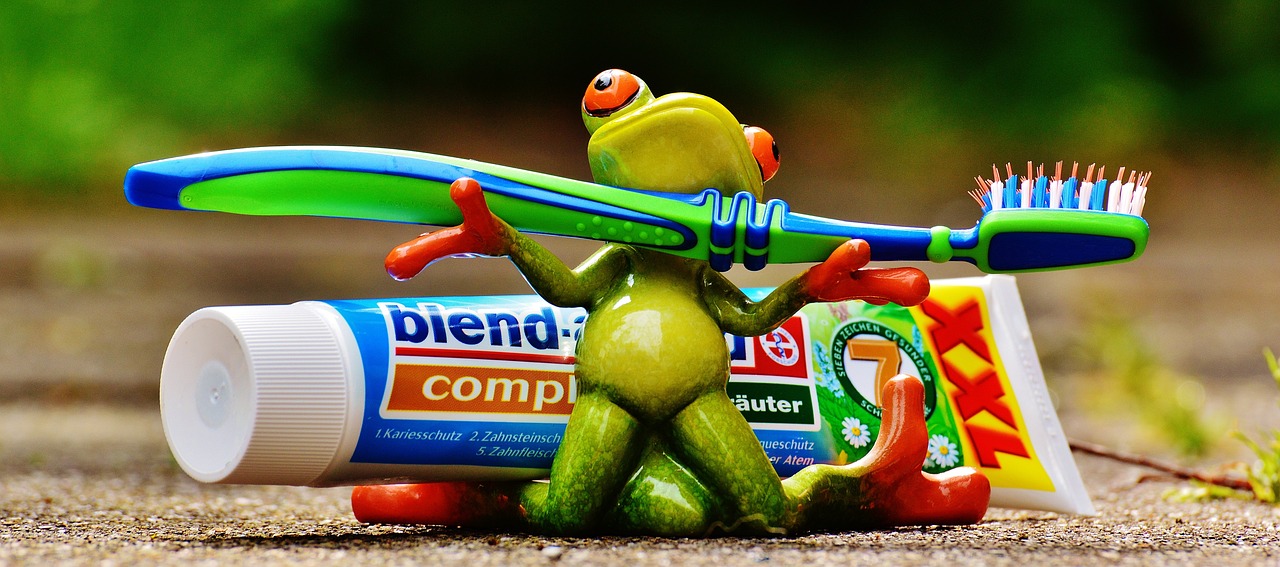
Tools for At-Home Dental Care
When it comes to maintaining your pet’s dental hygiene, having the right tools at home is absolutely essential. Just like we need our toothbrushes and floss, our furry friends require specific dental care products to keep their mouths healthy and happy. Regular at-home dental care can prevent serious issues down the road, potentially saving you from costly vet bills and keeping your pet comfortable. So, what tools should you be using? Let’s dive into the must-haves for at-home dental care!
First and foremost, toothbrushes designed specifically for pets are a game changer. These brushes often have softer bristles and are ergonomically designed to fit comfortably in your hand, making the brushing process easier for both you and your pet. There are various sizes available, so whether you have a tiny Chihuahua or a large Labrador, there’s a brush that’s perfect for your pet. Additionally, some toothbrushes come with dual heads for those hard-to-reach areas, ensuring a thorough clean.
Now, let’s talk about toothpaste. It’s crucial to use toothpaste that is formulated for pets. Human toothpaste can be toxic to animals, so always opt for pet-specific options. Many pet toothpastes come in flavors that appeal to your pet, like chicken or beef, making the process of brushing their teeth a bit more enjoyable. When you introduce brushing, start slowly, allowing your pet to lick the toothpaste off the brush first before you begin the actual brushing.
In addition to brushing, dental chews and treats can play a significant role in your pet’s oral health. These treats are designed to promote chewing, which helps to reduce plaque and tartar buildup. Look for products that have the Veterinary Oral Health Council (VOHC) seal of approval, as they have been tested and proven to be effective in promoting dental health. Incorporating these treats into your pet's routine can be a fun way to keep their teeth clean while also rewarding them.
Another handy tool is a dental spray or rinse. These products can be sprayed directly into your pet’s mouth or added to their water bowl to help reduce plaque and freshen breath. While they shouldn’t replace brushing, they can be an excellent supplement to your pet’s dental care routine, especially on days when you might not have time for a full brushing session.
Lastly, consider investing in dental toys. These toys are designed to be chewed on and can help clean your pet’s teeth while they play. They not only keep your pet entertained but also serve a dual purpose by promoting oral health. Look for toys made from durable materials that can withstand aggressive chewers, ensuring they last longer and provide maximum benefits.
In summary, maintaining your pet's dental health at home is not just about one tool or product; it's about creating a comprehensive routine that includes:
- Pet-specific toothbrushes
- Pet-safe toothpaste
- Dental chews and treats
- Dental sprays or rinses
- Dental toys
By incorporating these tools into your pet’s daily life, you’re taking significant steps toward ensuring their oral health and overall well-being. Remember, a little effort goes a long way in keeping those tails wagging and those smiles bright!
Q: How often should I brush my pet's teeth?
A: Ideally, you should brush your pet's teeth daily. However, even brushing a few times a week can significantly improve their dental health.
Q: Can I use human toothpaste on my pet?
A: No, human toothpaste can be harmful to pets. Always use toothpaste formulated specifically for animals.
Q: Are dental chews effective?
A: Yes, dental chews can help reduce plaque and tartar buildup, but they should complement regular brushing, not replace it.
Q: How can I tell if my pet has dental problems?
A: Look for signs like bad breath, difficulty eating, swollen gums, or changes in behavior. If you notice any of these, consult your veterinarian.
Brushing Techniques
Brushing your pet's teeth might seem like a daunting task, but it can be a rewarding experience for both you and your furry friend. Just like humans, pets can suffer from dental issues if their teeth aren't properly cared for. The right brushing techniques not only contribute to your pet's oral hygiene but also strengthen the bond between you and your beloved animal. So, how do you make brushing less of a chore and more of a fun routine? Let’s dive into some effective techniques that can make a world of difference!
First and foremost, choosing the right tools is crucial. You’ll need a toothbrush designed specifically for pets, which often features softer bristles and a shape that fits comfortably in their mouths. There are even finger brushes available that might be easier to maneuver, especially for smaller pets. Pair this with a toothpaste formulated for pets, as human toothpaste can be harmful to them. Remember, pets often have flavors like chicken or beef, which can make the experience more enjoyable for them.
Before you start brushing, it’s essential to get your pet accustomed to the process. Begin by letting them sniff and taste the toothpaste. This step is like a warm-up; it helps them associate the flavor with a positive experience. Once they seem comfortable, gently lift their lips to expose their teeth and gums. You can start with just a few teeth at a time, gradually increasing the number as they become more relaxed. Patience is key—if your pet seems anxious or resistant, take a break and try again later.
When it comes to the actual brushing, here are a few techniques to keep in mind:
- Angle the Brush: Hold the toothbrush at a 45-degree angle to the gum line. This position helps to effectively remove plaque and food particles.
- Use Gentle Pressure: Apply gentle pressure while brushing. Too much force can irritate their gums and cause discomfort.
- Focus on the Back Teeth: The back teeth are often the most neglected, yet they are crucial for chewing. Spend extra time on them.
Brushing should ideally be done daily, but if that’s not feasible, aim for at least two to three times a week. Just like with humans, consistency is vital for maintaining oral health. After brushing, reward your pet with praise or a small treat to reinforce the behavior. This positive reinforcement will make them more likely to cooperate during future sessions.
Lastly, remember to monitor your pet's oral health regularly. If you notice any signs of discomfort or changes in behavior, it might be time to consult your veterinarian. They can provide further guidance on dental care and recommend professional cleanings if necessary. By incorporating these brushing techniques into your routine, you’re not just cleaning teeth; you’re investing in your pet’s overall health and happiness!
Q: How often should I brush my pet's teeth?
A: Ideally, you should brush your pet's teeth daily. If that’s not possible, aim for at least two to three times a week.
Q: What if my pet doesn’t like having their teeth brushed?
A: Start slowly by letting them taste the toothpaste and getting used to the toothbrush. Gradually introduce brushing in a calm environment, and consider using a finger brush if they are more comfortable with that.
Q: Can I use human toothpaste for my pet?
A: No, you should not use human toothpaste as it can be toxic to pets. Always use toothpaste specifically formulated for pets.
Q: What are some signs that my pet might have dental issues?
A: Look for signs like bad breath, difficulty eating, swollen gums, or changes in behavior. If you notice any of these, consult your veterinarian.
Dental Treats and Toys
When it comes to maintaining your pet's oral health, can be game changers. These specially designed products not only entertain your furry friend but also play a crucial role in keeping their teeth and gums healthy. Imagine your pet happily chewing away while simultaneously fighting plaque and tartar buildup—it's like a win-win situation! But how do these treats and toys actually work, and what should you look for when choosing the right ones?
First, let's dive into the types of dental treats available. Many of these treats are formulated with ingredients that help reduce plaque and tartar. They often have a texture that scrubs the teeth as your pet chews, providing a mechanical cleaning action. Look for treats that are vet-approved and specifically labeled for dental health. Some popular options include:
- Chewy dental sticks: These are designed to be chewed, helping to clean teeth and freshen breath.
- Dental biscuits: Crunchy treats that can help scrape away plaque as your pet bites into them.
- Rawhide alternatives: Made from safer materials, these can also assist in cleaning teeth while being easier to digest.
Now, let’s talk about dental toys. These are not just any toys; they are specifically designed to promote oral health. Many dental toys are made from rubber or nylon and have ridges or bumps that help massage gums and remove debris from teeth. When selecting a dental toy, ensure it's the right size for your pet to prevent choking hazards. Additionally, consider the material—some pets are aggressive chewers and need tougher toys that can withstand their enthusiasm.
Incorporating dental treats and toys into your pet's routine can be a fun and effective way to promote good oral hygiene. However, it’s important to remember that these should complement, not replace, regular brushing and professional dental cleanings. Think of dental treats and toys as a supporting act in the grand performance of your pet’s dental care. They can help maintain oral health between visits to the vet, but they are not a substitute for complete dental care.
Lastly, while dental treats and toys can be beneficial, moderation is key. Too many treats can lead to weight gain, which brings its own set of health issues. Always check the caloric content of the treats and adjust your pet's daily food intake accordingly. Your vet can provide personalized recommendations based on your pet's dietary needs and health status.
In summary, dental treats and toys are fantastic tools in the quest for a healthier mouth for your pet. They offer a fun way to engage with your pet while ensuring their teeth are kept in tip-top shape. So, next time you're at the pet store, take a moment to explore the dental aisle—your furry friend will thank you!
- How often should I give my pet dental treats? It's best to consult your vet, but generally, giving dental treats a few times a week can be beneficial.
- Are all dental treats safe for my pet? Not all dental treats are created equal. Always choose products that are specifically designed for dental health and are appropriate for your pet's size and breed.
- Can dental toys replace brushing? While dental toys can help maintain oral health, they should not replace regular brushing and professional cleanings.
Frequently Asked Questions
-
How can I tell if my pet has dental problems?
Look out for signs like bad breath, difficulty in eating, or swollen gums. If your furry friend seems to be more aggressive or withdrawn, it could indicate oral pain. Regularly check their gums for redness or swelling, as healthy gums are crucial for overall dental health.
-
What are the common dental issues pets face?
Pets often suffer from periodontal disease and tooth decay. These issues can lead to serious health problems if not addressed. Just like us, pets need proper dental care to keep their teeth and gums healthy.
-
How often should I take my pet for dental check-ups?
It's recommended to schedule routine veterinary dental check-ups at least once a year. Regular evaluations and cleanings can help prevent serious dental issues from developing and keep your pet's mouth healthy.
-
What tools can I use for at-home dental care?
You can use a variety of tools such as pet toothbrushes, toothpaste specifically designed for pets, and dental chews. These products can help maintain your pet’s dental hygiene between vet visits.
-
What are some effective brushing techniques for my pet?
When brushing your pet's teeth, use gentle circular motions and focus on the gum line. Make it a positive experience by rewarding your pet with treats or praise afterward. Consistency is key, so try to brush their teeth several times a week!
-
Do dental treats and toys really help?
Absolutely! Special dental treats and toys are designed to promote oral hygiene. They can help reduce plaque and tartar buildup while keeping your pet entertained. Incorporating these into your pet's routine can lead to healthier teeth and gums.

